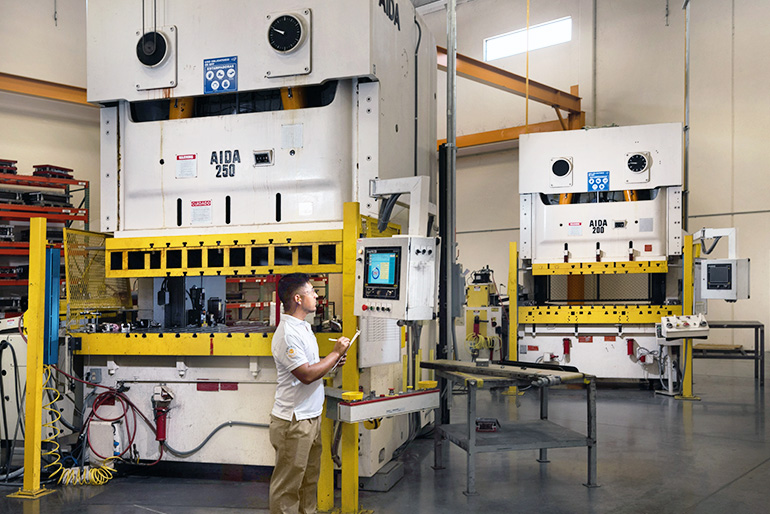Discover the current Developments in Metal Stamping for Accuracy Production
Discover the current Developments in Metal Stamping for Accuracy Production
Blog Article
Checking Out the Globe of Steel Stamping: From Design to Production
Within the realm of manufacturing, metal stamping stands out as a precise and efficient method for forming steel sheets right into various forms with impressive uniformity. From the first design phase where elaborate patterns materialize to the complex manufacturing procedures, metal marking is a mix of artistry and engineering. Exploring this globe introduces a complicated interplay of creative thinking and technological proficiency, supplying a look right into a world where technology fulfills workmanship.
History of Metal Stamping
Metal stamping, an extensively made use of production procedure today, has an abundant history that dates back to ancient times (Metal Stamping). The beginnings of steel stamping can be traced to ancient people such as the Egyptians, who used marking strategies to decorate fashion jewelry and ornaments with intricate designs. With time, steel stamping progressed, with worlds like the Greeks and Romans utilizing it for developing coins and attractive products

In the 20th century, metal stamping remained to advance with the combination of automation and computer system mathematical control (CNC) innovation. These improvements further increased the efficiency and accuracy of steel stamping processes, making it an essential part of modern production across sectors such as automobile, aerospace, and electronic devices. Today, metal stamping continues to be an important manufacturing procedure, combining custom with innovation to satisfy the needs of a continuously advancing industry.
Style Factors To Consider and Prototyping
When establishing steel stamping jobs, thorough attention to create factors to consider and prototyping is vital for making certain optimal manufacturing results. Layout considerations in metal marking consist of product selection, part geometry, tooling style, and manufacturing feasibility. Selecting the best product is critical as it impacts the part's efficiency, cost, and manufacturability. Part geometry influences the intricacy of the marking procedure and the capability of the end product. Tooling design plays a considerable role in the success of metal stamping projects, impacting part accuracy, tool durability, and manufacturing effectiveness.
Prototyping is a vital phase in the steel stamping procedure that enables engineers to examine the style, confirm manufacturability, and make needed adjustments prior to full-scale manufacturing. By thoroughly taking into consideration design elements and utilizing prototyping, suppliers can improve the steel stamping procedure and accomplish high-quality, cost-efficient production end results.
Tooling and Devices Basics
Thinking about the critical function that tooling layout plays in the success of metal marking projects, recognizing the necessary tools and devices called for is paramount for accomplishing reliable production results. Tooling is a basic aspect of steel stamping, as it directly influences the quality and consistency of the end products. Vital tools consist of passes away, strikes, and components, which are custom-designed to shape and create the steel into the desired parts. Passes away are the key tool utilized to cut and develop the steel, while strikes aid create holes or certain forms. Components hold the steel in area during the stamping process, making sure precision and repeatability. In addition, equipment such as stamping presses, feeders, and coil handling systems are important click resources for automating the marking process and enhancing efficiency. Purchasing high-grade tooling and equipment not only improves production efficiency but also causes greater accuracy, lowered waste, and total price financial savings in steel marking procedures.
Production Process and Top Quality Control
Efficiently handling the manufacturing process and applying robust high quality control measures are necessary for ensuring the success of metal stamping jobs. The production process in steel stamping entails a series of steps that should be thoroughly worked with to achieve ideal results.
Quality control in metal stamping is vital to supply items that meet the required specifications. Checking the stamped components at different phases of manufacturing aids identify any kind of defects at an early stage, stopping expensive rework or scrap. Methods such as dimensional assessment, aesthetic assessment, and material testing are typically employed to make sure the high quality of the stamped components. By preserving stringent quality go now assurance standards, producers can copyright their credibility for delivering top quality steel marked items.
Applications and Industry Insights
In the realm of metal stamping, the successful application of production processes and high quality control procedures straight affects the performance and integrity of numerous sector applications and gives valuable understandings right into the sector's functional characteristics. In addition, steel marking promotes the manufacturing of different family home appliances, including refrigerators, washing devices, and ovens, by providing cost-effective solutions for making sturdy and intricate components. Comprehending the applications and market understandings of steel stamping is essential for optimizing manufacturing Metal Stamping procedures and boosting item high quality across different markets.

Final Thought
To conclude, metal marking has an abundant history and plays a crucial duty in different industries. Design considerations, prototyping, tooling, tools, production processes, and quality assurance are necessary aspects of steel marking. With its widespread applications and sector insights, metal marking remains to be a flexible and efficient production process. By recognizing and using the concepts of metal stamping, makers can achieve high-quality, accuracy parts for a selection of products.
Report this page